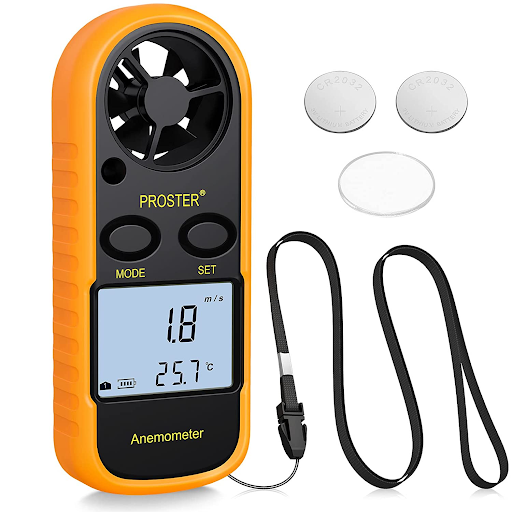
Wind speed meters, also called anemometers, measure the speed and course of the wind. They are used in many industries, including weather forecasting, aviation, and marine navigation. Understanding wind pace and direction is crucial for protection and efficiency in these industries, making wind pace meters a vital tool.
Types of Wind Speed Meters
There are numerous types of wind speed meters to be had in the marketplace, with blessings and downsides. The most common forms of wind pace meters consist of :-
Cup Anemometers – This kind of anemometer includes 3 or 4 cups connected to a valuable axis. As the wind blows, the cups spin, and the speed is measured by how quickly they rotate. Cup anemometers are easy, reliable, and broadly utilized in weather stations.
Vane Anemometers – Vane anemometers include a small propeller that rotates while the wind blows. The degree of wind speed is primarily based on the rate of the propeller’s rotation. Vane anemometers are often utilized in aviation and marine applications.
Sonic Anemometers: Sonic anemometers use sound waves to measure wind pace and route. They are accurate and can measure wind speed in all guidelines, making them ideal for complicated wind environments.
Hot-Wire Anemometers: Hot-twine anemometers use a heated wire cooled by the wind. The cooling effect is measured to determine the wind speed. Hot-twine anemometers are enormously touchy and can measure very low wind speeds correctly. Understanding Wind Speed Units Wind speed is usually measured in meters per second (m/s) or kilometers per hour (km/h).
In a few cases, it may be measured in miles per hour (mph) or knots (nautical miles per hour). Understanding the specific gadgets is vital for decoding wind speed records appropriately.
In widespread use, wind speeds of less than five m/s are considered calm, even though wind speeds above 25 m/s are considered sturdy. Wind speeds greater than 60 m/s are considered storm pressure; at the same time, wind speeds greater than 100 and twenty m/s are considered twister strength.
Applications of Wind Speed Meters Wind speed meters are utilized in various packages, consisting of :-
Weather Forecasting: Wind speed meters are an essential tool for climate forecasting. They offer essential records on wind speed and direction used to create climate models and forecasts.
Aviation: Wind speed meters offer pilots real-time wind speed and direction statistics. This information assists pilots in adjusting their flight paths and landing safely. Marine Navigation: Wind speed meters offer sailors real-time wind speed and course information. This information assists sailors in altering their sail positions and navigating properly.
Wind Energy: Wind speed meters are utilized in wind energy programs to measure wind pace and direction. These statistics are used to determine windmills’ highest-quality placement and orientation. How Wind Speed Meters Work Wind speed meters measure the pressure and pace of the wind because it passes over a sensor. This sensor then converts the mechanical strength of the wind into an electrical signal that can be measured and analyzed.
Depending on the type of wind pace meter, one-of-a-kind sensors, and methods are used to measure the wind’s force and pace. Cup anemometers, for example, use cups that are fashioned like miniature windmills to measure the wind’s force. As the wind blows beyond the cups, they rotate, with the rotation speed proportional to the wind’s speed. The frequency of this rotation can then be converted into a dimension of wind speed.
Vane anemometers, on the other hand, use a small propeller that rotates when the wind blows past it. The speed of the propeller’s rotation is proportional to the wind’s speed, which may be used to calculate the wind’s pressure and route.
Sonic anemometers work through the use of sound waves to measure the wind’s pace and path. They use a pair of microphones that can be separated at a certain distance. The sound waves are distorted predictably as the wind blows beyond those microphones. By measuring those distortions, sonic anemometers can calculate the wind’s pace and route with high accuracy.
Hot-twine anemometers use a thin, heated cord suspended in the wind. As the wind blows past the twine, it cools down, and the quantity of cooling is proportional to the wind’s pace. By measuring the quantity of cooling, warm-cord anemometers can calculate the wind’s speed and route.
Choosing the Right Wind Speed Meter [https://adkinstruments.in/categories/measuring-devices/wind-speed-meter] When selecting a wind speed meter, it is crucial not to forget the specific desires of the utility. Factors to remember consist of Accuracy – Different wind speed meters have unique accuracy ranges.
For a few programs, which include aviation and marine navigation, excessive levels of accuracy are vital, while for others, including wind electricity, barely lower accuracy may be applicable.
Range: Wind speed meters have distinct ranges, with some capable of very low wind speeds and others designed for typhoon-pressure winds. Choosing a meter with an appropriate variety is vital to ensuring correct measurements.
Durability – Some wind speed meters are designed to be used in harsh environments, which include offshore marine applications or mountaintop weather stations. It is critical to choose a meter that is long-lasting enough to resist the surroundings it will be utilized in.
Ease of Use: Wind pace meters can vary in complexity, with some requiring technical understanding or schooling. Choosing a meter that is easy to apply and recognize is essential to ensure accurate measurements.
Cost: Wind pace meters can vary in price, some being cheaper and others costing hundreds of dollars. Balancing the meter’s cost with the software’s desires is a critical consideration. Conclusion Wind pace meters are critical tools for many packages, supplying essential facts on wind pace and route.
This is used to ensure safety and performance. Choosing the proper meter for the activity requires careful attention to accuracy, variety, durability, ease of use, and price. Understanding the unique styles of wind speed meters and how they are painted is important for selecting the proper device and accurately deciphering wind speed information.








